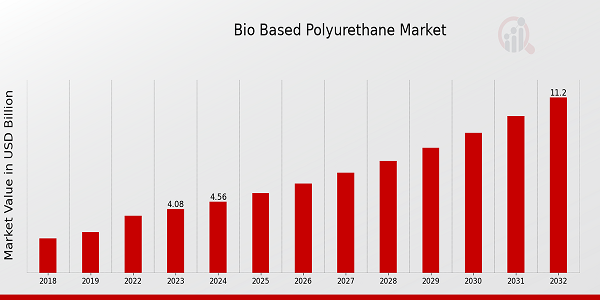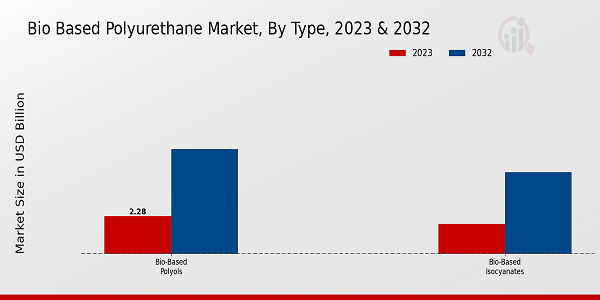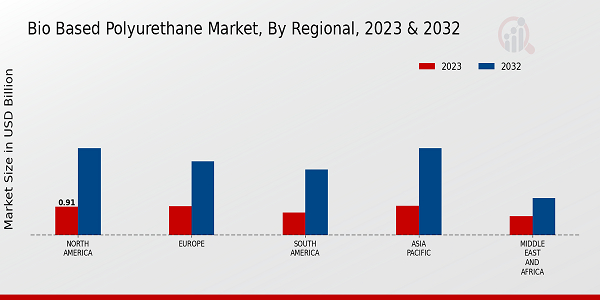Global Bio-Based Polyurethane Market Overview
The Bio-Based Polyurethane Market Size was estimated at 5.1 (USD Billion) in 2024. The Bio-Based Polyurethane Industry is expected to grow from 5.71 (USD Billion) in 2025 to 15.69 (USD Billion) by 2034. The Bio-Based Polyurethane Market CAGR (growth rate) is expected to be around 11.90% during the forecast period (2025 - 2034).
Key Bio-Based Polyurethane Market Trends Highlighted
The growth in the demand for bio-based polyurethane products around the world has been a result of increased concerns about environmental issues and the ready acceptance of sustainable materials. The growing Bio-Based polyol market is also ready for big leaps as a result of the compliance guidelines and the increasing willingness of consumers to go for green products. While there are alternatives like polyether and polyurethanes, the drive towards bio-based feedstocks aligns with climate change efforts that lead to less carbon. This environmentalism is helping to drive the new market, enabling companies to target the growth potential that exists in the biodegradable and renewable plastic markets. Recent developments show a positive movement towards plant and Bio-Based building blocks like castor oil-derived polyols and vegetable oil-based polyols, which are used in producing Bio-Based polyurethanes with improved characteristics. Aside from that, the development of efficient biocatalysts has also paved the way for the production of high-performance bio polyurethanes, thus increasing the scope of applying these materials.
 Source: Primary Research, Secondary Research, MRFR Database and Analyst Review
Source: Primary Research, Secondary Research, MRFR Database and Analyst Review
Bio-Based Polyurethane Market Drivers
Rising Demand for Sustainable Materials
The increasing awareness of environmental issues and the growing demand for sustainable materials are some of the factors driving the growth of the Bio-Based Polyurethane Market Industry Lifecycle. Bio-based polyurethanes are derived from natural resources such as plant oils and biomass, making them an eco-friendly alternative to fossil fuel-based polyurethanes. There is a rising demand for products that are more sustainable and environmentally friendly as consumers are increasingly becoming more concerned about the products that they are using.At the same time, the governments have also implemented several policies and regulations that are intended to reduce greenhouse gas emissions and promote the use of renewable resources. There is an increasing use of bio-based materials in a number of industries, including the automotive, construction, and packaging industries, among others. The companies are encouraged to use bio-based polyurethanes through notifications and policy initiatives, which are good examples of such measures.The demand for sustainable materials is likely to continue to rise with the growing awareness of environmental problems and more stringent regulation, so it can be said that the Bio-Based Polyurethane Market Industry Lifecycle is in the growth phase. Conclusion The future growth of the bio-based polyurethane sector will be defined by the growing awareness of people regarding environmental issues, combined with a number of policy initiatives that aim to reduce greenhouse gas emissions.There is an increasing use of sustainable materials, so it can be concluded that the segment is in the growth phase.
Technological Advancements
Technological advances are playing a key role in the development of the Bio-Based Polyurethane Market Industry. Research and development focusing on bio-based polyurethanes’ improved performance and properties. For instance, researchers are developing bio-based polyurethanes with superior mechanical strength, durability, and chemical and heat resistivity. This has made bio-based polyurethanes more competitive with conventional petroleum-based polyurethanes.Consequently, the market has expanded due to the increased use of the product. Additionally, technology has made it possible for new materials to be developed, creating several uses for bio-based polyurethanes. For example, bio-based polyurethanes are used to create new foams, coatings, and glues.
Growing Applications in Various Industries
Many industries, including automotive, construction, and packaging, use bio-based polyurethanes. Particularly in automotive, they are applied in the production of interior components, such as seats, dashboards, and door panels. In construction, bio-based polyurethanes are used in the production of insulation, roofing, and flooring. Finally, packaging is used in the production of films, coatings, and adhesives. In general, the development of new application areas for bio-based polyurethanes drives the growth in the Bio-Based Polyurethane Market Industry.This is expected as, with the development of new applications, the demand for bio-based polyurethanes will also grow larger.
Bio-Based Polyurethane Market Segment Insights
Bio-Based Polyurethane Market Type Insights
The Bio-based Polyols segment held the largest market share in 2023, and it is expected to continue to dominate the market during the forecast period. The growth of this segment can be attributed to the increasing demand for bio-based materials, as well as the rising awareness of the environmental benefits of using bio-based products. Bio-based polyols are derived from renewable resources, such as plant oils and sugars, and they offer a number of advantages over traditional petroleum-based polyols, including reduced greenhouse gas emissions, improved biodegradability, and enhanced performance.The Bio-based Isocyanates segment is expected to experience significant growth during the forecast period, due to the increasing demand for bio-based polyurethane products. Bio-based isocyanates are derived from renewable resources, such as plant oils and animal fats, and they offer a number of advantages over traditional petroleum-based isocyanates, including reduced toxicity, improved biodegradability, and enhanced performance. The market growth is attributed to the rising demand for bio-based materials, increasing awareness of environmental sustainability, and growing applications of bio-based polyurethane in various industries such as automotive, construction, and packaging.The Asia Pacific region is expected to witness the highest growth rate due to the increasing demand for bio-based polyurethane in emerging economies like China and India.
 Source: Primary Research, Secondary Research, MRFR Database and Analyst Review
Source: Primary Research, Secondary Research, MRFR Database and Analyst Review
Bio-Based Polyurethane Market Application Insights
The Bio-Based Polyurethane Market is segmented by Application into Automotive, Building and Construction, Furniture and Bedding, Consumer Goods, and Packaging. The Automotive segment held the largest market share in 2023 and is expected to continue to dominate the market over the forecast period. The Building and Construction segment is expected to experience significant growth over the forecast period, driven by the increasing demand for sustainable building materials. The Furniture and Bedding segment is also expected to witness steady growth, owing to the growing popularity of bio-based and eco-friendly furniture.The Consumer Goods segment is expected to grow at a moderate pace, driven by the increasing demand for bio-based and sustainable products in various consumer applications. The Packaging segment is expected to experience moderate growth, driven by the increasing demand for sustainable packaging solutions.
Bio-Based Polyurethane Market End-Use Industry Insights
The Bio-Based Polyurethane Market segmentation by end-use industry provides valuable insights into the specific applications of bio-based polyurethane across various industries. In 2023, the automotive transportation segment dominated the market with a revenue of USD 1.2 billion, driven by the increasing demand for lightweight and sustainable materials in vehicle manufacturing. The construction industry is projected to witness significant growth, reaching a value of USD 1.8 billion by 2032, as bio-based polyurethane offers excellent insulation properties and durability.The furniture interiors segment is expected to grow steadily, with a revenue of USD 1.1 billion in 2032, driven by the increasing use of bio-based polyurethane in furniture, bedding, and upholstery. Consumer products, packaging, and other end-use industries are also expected to contribute to the overall market growth. These insights are crucial for businesses operating in the Bio-Based Polyurethane Market as they can tailor their strategies to meet the specific needs of each end-use industry.
Bio-Based Polyurethane Market Raw Material Source Insights
Soybeans are the most commonly used raw material source for Bio-Based polyurethane, accounting for over 50% of the market share. This is due to the high availability and low cost of soybeans. Corn is another important raw material source, particularly in North America. Palm oil is a major raw material source in the Asia Pacific, while sugarcane is primarily used in South America. Other plant-based oils, such as castor oil and rapeseed oil, are also used in the production of Bio-Based polyurethane. The growth of the market is attributed to the increasing demand for sustainable and environmentally friendly materials.
Bio-Based Polyurethane Market Processing Technology Insights
Direct Substitution, Chemical Modification, and Biocatalysis are the three primary processing technologies used in the bio-based polyurethane market. Direct Substitution involves using bio-based materials to replace petroleum-based materials directly in existing polyurethane production processes. Chemical Modification entails chemically altering bio-based materials to make them compatible with polyurethane synthesis. Biocatalysis employs enzymes or microorganisms to catalyze specific reactions in the production of bio-based polyurethanes.In 2023, Direct Substitution held the largest share of the market due to its simplicity and cost-effectiveness. Chemical Modification is expected to witness significant growth over the forecast period as it offers greater flexibility in tailoring bio-based polyurethanes for specific applications. Biocatalysis, though still in its early stages of development, holds immense potential for producing high-performance bio-based polyurethanes with unique properties. The Bio-Based Polyurethane Market is expected to reach 11.2 Billion USD by 2032, exhibiting a CAGR of 11.89% during the forecast period.This growth is attributed to rising demand for sustainable and eco-friendly materials, coupled with government regulations promoting the use of bio-based products.
Bio-Based Polyurethane Market Regional Insights
The regional segmentation of the Bio-Based Polyurethane Market offers valuable insights into market behavior and dynamics across different geographical regions. North America is anticipated to account for a sizable share of the market, driven by stringent environmental regulations and increasing demand for bio-based materials. Europe is another key region, with significant contributions from countries like Germany and the United Kingdom. APAC is expected to witness substantial growth due to the rapidly expanding automotive industry and government initiatives promoting sustainable practices.South America and MEA are expected to contribute a smaller but growing share, with potential opportunities in emerging markets. Understanding regional variations in demand trends, regulatory frameworks, and competitive landscapes provides vital information for businesses operating in the Bio-Based Polyurethane Market.
 Source: Primary Research, Secondary Research, MRFR Database and Analyst Review
Source: Primary Research, Secondary Research, MRFR Database and Analyst Review
Bio-Based Polyurethane Market Key Players and Competitive Insights:
Major players in the Bio-Based Polyurethane Market industry are constantly striving to gain a competitive edge by investing in research and development, expanding their product portfolios, and forming strategic partnerships. Leading Bio-Based Polyurethane Market players are focusing on developing sustainable and eco-friendly Bio-Based Polyurethane Market products to meet the growing demand for environmentally conscious products. The Bio-Based Polyurethane Market industry is characterized by intense competition, with companies vying for market share through innovation, cost optimization, and strategic alliances. Key players in the Bio-Based Polyurethane Market are adopting various strategies such as mergers and acquisitions, joint ventures, and collaborations to strengthen their market position and expand their reach. The Bio-Based Polyurethane Market industry is expected to witness further consolidation in the coming years as companies seek to gain economies of scale and enhance their competitive advantage.BASF SE, a leading player in the Bio-Based Polyurethane Market industry, is committed to sustainability and innovation. The company offers a range of Bio-Based Polyurethane Market products under its Elastollan brand, which are derived from renewable resources. BASF SE focuses on developing high-performance Bio-Based Polyurethane Market solutions for various applications, including automotive, construction, and footwear. The company's strong presence, extensive research and development capabilities, and commitment to sustainability make it a formidable player in the Bio-Based Polyurethane Market.Another prominent player in the Bio-Based Polyurethane Market is The Dow Chemical Company. The company's Bio-Based Polyurethane Market offering includes a wide range of products under its Ecolibrium brand, which are designed to meet the needs of eco-conscious consumers. The Dow Chemical Company emphasizes sustainability throughout its operations, from raw material sourcing to product manufacturing and disposal. The company's commitment to innovation and its strong customer base have contributed to its success in the Bio-Based Polyurethane Market.
Key Companies in the Bio-Based Polyurethane Market Include:
Bio-Based Polyurethane Market Industry Developments
Increasing demand for sustainable and eco-friendly materials, coupled with growing environmental concerns and regulations, is driving the market growth. The automotive industry is a major consumer of bio-based polyurethanes, utilizing them in the production of lightweight and fuel-efficient vehicles. Moreover, the construction sector is witnessing rising adoption of bio-based polyurethanes for insulation and energy-efficient building materials. Key industry players are focusing on research and development to enhance the performance and applications of bio-based polyurethanes, creating new opportunities for market expansion.
Bio-Based Polyurethane Market Segmentation Insights
Bio-Based Polyurethane Market Type Outlook
-
Bio-based Polyols
-
Bio-based Isocyanates
Bio-Based Polyurethane Market Application Outlook
Bio-Based Polyurethane Market End-Use Industry Outlook
Bio-Based Polyurethane Market Raw Material Source Outlook
-
Soybeans
-
Corn
-
Palm Oil
-
Sugarcane
-
Other Plant-Based Oils
Bio-Based Polyurethane Market Processing Technology Outlook
-
Direct Substitution
-
Chemical Modification
-
Biocatalysis
Bio-Based Polyurethane Market Regional Outlook
-
North America
-
Europe
-
South America
-
Asia Pacific
-
Middle East and Africa
| Report Attribute/Metric |
Details |
| Market Size 2024 |
5.1 (USD Billion) |
| Market Size 2025 |
5.71 (USD Billion) |
| Market Size 2034 |
15.69 (USD Billion) |
| Compound Annual Growth Rate (CAGR) |
11.90% (2025 - 2034) |
| Report Coverage |
Revenue Forecast, Competitive Landscape, Growth Factors, and Trends |
| Base Year |
2024 |
| Market Forecast Period |
2025 - 2034 |
| Historical Data |
2020 - 2024 |
| Market Forecast Units |
USD Billion |
| Key Companies Profiled |
The Dow Chemical Company, BASF, Solvay, Perstorp, Huntsman Corporation, Eastman Chemical Company, Archroma, Evonik, DSM, Bayer MaterialScience, DIC Corporation, Mitsubishi Chemical Holdings Corporation, Lanxess, Covestro, Arkema |
| Segments Covered |
Type, Application, End-Use Industry, Raw Material Source, Processing Technology, Regional |
| Key Market Opportunities |
Rising demand for sustainable products, bio-based feedstock accessibility, growing automotive sector, expanding construction industry, and increasing investments in research and development |
| Key Market Dynamics |
Increasing demand for sustainable materials Technological advancements Growing awareness of environmental concerns Government regulations promoting biobased products Expanding applications in automotive and construction industries |
| Countries Covered |
North America, Europe, APAC, South America, MEA |
Frequently Asked Questions (FAQ) :
The Bio-Based Polyurethane Market is projected to reach a valuation of approximately USD 5.71 billion in 2025.
The market is anticipated to expand at a CAGR of 11.90% from 2025 to 2034.
The market is projected to reach a valuation of around USD 15.69 billion by 2034.
North America is anticipated to dominate the market due to the increasing demand for bio-based materials and the presence of a large automotive industry in the region.
Bio-Based Polyurethane is used in various applications such as automotive interiors, footwear, furniture, and coatings.
Major players in the market include BASF, Covestro, The Dow Chemical Company, Huntsman Corporation, and Bayer Material Science
The market is primarily driven by the increasing demand for sustainable and environmentally friendly materials, rising environmental concerns, and government regulations promoting bio-based products.
The market faces challenges such as the relatively higher cost of bio-based polyurethane compared to traditional polyurethane, limited availability of raw materials, and technical barriers in processing and manufacturing.
The COVID-19 pandemic had a moderate impact on the market, causing temporary disruptions in supply chains and demand from key end-use industries such as automotive and construction.
The market is expected to witness continued growth in the coming years, driven by advancements in technology, increasing consumer awareness about sustainability, and supportive government policies promoting the adoption of bio-based materials.






 Source: Primary Research, Secondary Research, MRFR Database and Analyst Review
Source: Primary Research, Secondary Research, MRFR Database and Analyst Review Source: Primary Research, Secondary Research, MRFR Database and Analyst Review
Source: Primary Research, Secondary Research, MRFR Database and Analyst Review Source: Primary Research, Secondary Research, MRFR Database and Analyst Review
Source: Primary Research, Secondary Research, MRFR Database and Analyst Review







